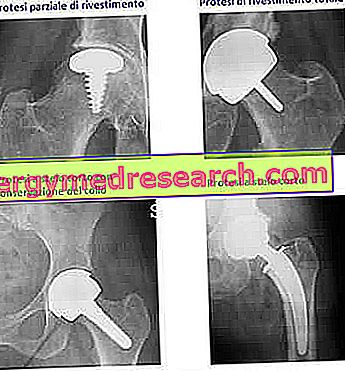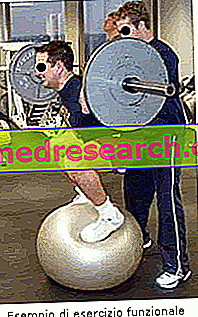Post-operative course
The post-operative course after a hip replacement procedure involves several obligatory stages, which are used for a speedy recovery and for the resumption of normal daily life.
THE FIRST DAYS
At one time, patients were forced into immobility, in a bed, for several tens of days. Today, however, thanks to current surgical techniques and new prostheses, they can start moving again, obviously with the help of crutches, already on the day of surgery.
Therefore, hospitalization is not long and is between 3 and 5 days.
Two recommendations are very important:
- when you are lying in bed to rest, it is good to keep a pillow between your legs, so that your hip remains in the correct position;
- it is useful to wear stuffed clothes, which preserve the wound from physical insults.
RECOVERY TIMES
The patient must use crutches, with the appropriate caution, for at least 4-6 weeks. This is the time it takes for the wound and the ligament-ligament apparatus to heal and return to normal.
As long as walking is reduced, anticoagulant injections should be given (eg heparin ), to prevent blood clots forming in the legs.
If the patient adheres strictly to the rehabilitation exercises and does not force the times, the total recovery and the resumption of normal activities takes place after 2 or 3 months. Among the normal activities, the practice of some sports is also included, those in which there are no sudden movements and contact bumps. Therefore, we strongly advise against practicing football, skiing, horse riding, rugby etc.
In the following table, the average times for the return to some common daily activities are summarized.
| Activities | How long can you resume? | Short description |
| To drive | 6 weeks after the operation | The patient may have difficulty entering and leaving the car. One solution may be to sit and turn around in the seat with the legs parallel. |
| Work | 6-12 weeks after the operation | The times depend on the type of work. If sedentary, recovery obviously requires less time. |
| Sex life | 6-8 weeks after the operation | It is best to wait for the doctor's consultation. |
PAIN AND TIRES
Post-operative pain is one of the most feared problems for patients.
However, it is normal to feel it, especially after an invasive operation such as hip replacement. The time required, for its exhaustion, varies from patient to patient; in any case, it is not particularly long.
The same goes for the continuing feeling of tiredness . In fact, it too must not worry, as it is a natural consequence, after the intervention.
WHAT DO YOU HAVE TO WORRY?
The signs, which must draw the patient's attention, are three:
- Redness occurring at the wound
- Progressive increase in pain, rather than its decline
- Edema at the wound
In their presence, it is recommended to seek urgent medical attention.
PERIODICAL CHECKS
The first post-intervention check should be carried out by the attending physician after approximately 6-12 weeks.
If healing is proceeding regularly, the second check is set at exactly one year away from the first.
Finally, if the second medical consultation is also positive, the subsequent checks must be carried out every 5 years. On these occasions, an X-ray examination is also performed to assess the state of wear of the prosthesis.
MOVEMENTS AND GESTURES TO AVOID
The post-operative period is delicate and every small detail needs to be taken care of, if you want to recover better. Therefore, sudden movements and extreme positions should be avoided.
- Avoid flexing the hip at an angle greater than 90 °, during each activity
- Avoid performing hip rotation movements
- Do not pivot on the operated leg
- Turn around in small steps
- Avoid compressing the wound (when sleeping, for example)
- Don't cross your legs
- Avoid chairs that are too low and have a raised toilet at home
REHABILITATION
Rehabilitation is essential to recover full articular mobility in the established times.
It starts already after discharge from the hospital and consists of a program of exercises to be performed in the gym. Here, the patient must rely on the care and advice of a physiotherapist, who proposes the exercises to be performed and corrects any errors in execution.
Rehabilitation is an important moment, not only for physical recovery, but also for psychological recovery. The feeling of pain, suffered at the beginning of the recovery path, can discourage the patient, but the support offered by the people around him can help him overcome these difficulties.
THE DURATION OF A PROSTHESIS
A prosthesis generally lasts between 15 and 20 years, depending on the model used.
As we have seen, post-operative recovery is long and deserves the right attention. Therefore, postponing the second intervention, even if a couple of years, thanks to the graft of a long-lived prosthesis, is not a negligible detail (in particular for younger patients).
RESULTS
The first hip prosthesis was applied in the 1960s. In these years, the technique has improved visibly and the benefits enjoyed by patients undergoing the operation are tangible. Not surprisingly, it is considered one of the most effective surgical procedures.
The patient, after rehabilitation, can return to lead a normal life of good quality.
Risks of the intervention
The hip replacement procedure is almost always resolved in a positive way. However, according to some statistical data, one in 10 cases is subject to complications. In some of these situations, the patient must undergo correction surgery .
Furthermore, it is recently reported that prostheses with metal head and insert ( metal / metal prosthesis ) cause damage to the surrounding bone tissue and more.
COMPLICATIONS
The most common complications are:
- The loosening of the prosthesis.
Characteristics: occurs when the bond between the stem of the prosthesis and the remaining femur becomes weaker. It is a classic situation, which occurs around the tenth-fifteenth year of age of the prosthesis.
Symptoms: pain and feeling of instability.
Solution: a corrective surgical operation is needed.
- Hip dislocation .
Features: occurs when the head "escapes" from the cup. It is more common in the first months after surgery.
Solution: surgery is needed to replace the prosthesis.
- Premature wear.
- Joint stiffening.
Characteristics: the soft tissues, which surround the prosthesis, can harden, thus compromising joint mobility. It occurs especially in older patients.
Solution: non-surgical therapy exists.
The most serious complications, on the other hand, concern the possibility of developing thrombosis or infections . These are events that occur very rarely: one case per 100.
Thrombosis is due to the semi-immobility to which the patient is forced. As is known, in fact, the immobility of the limbs can cause the formation of blood clots inside the veins, which hinder the normal blood flow.
Infections, on the other hand, arise due to bacterial proliferation, which affects the tissues surrounding the prosthesis. The patient notices this, as there is swelling, redness and pain at the hip.
METAL-METAL DAMAGES
It is quite recent (2010) the discovery that metal head and insert prostheses can have a damaging effect on the wearer. Since then, the Medicines and Healthcare products Regulatory Agency (MHRA) has drawn up specific guidelines, for those who have undergone a plant of this kind, which provide for annual checks.
But what are the effects of these prostheses? The metals of the prosthesis, in contact with each other, react, corroding the surrounding bones and spreading into the bloodstream. In fact, blood tests conducted on patients with metal / metal prostheses show traces of chromium in the serum .
The investigations concerning these inconveniences are continuing to understand the circumstances under which the prostheses in question become harmful.
Alternative hip replacement implant
There are two alternative interventions to the complete prosthesis:
- The covering prosthesis
- The short stem prosthesis

Figure: hip replacement alternative to the classic model. From the site: hcitalia.it
The covering prosthesis involves the preservation of the femoral head and the application of a simple metallic coating in the cavity of the acetabulum. Bone removal is minimal.
The short stem prosthesis, on the other hand, is similar to the classic one, but the stem is considerably smaller. Part of the femur is removed, but the portion of the body removed is considerably smaller than with a complete prosthesis.
ADVANTAGES AND DISADVANTAGES
These two alternative prostheses have a big advantage: they are less invasive . On the other hand, however, they are also less efficient, as they do less "grip" on the graft bones (on the femur in particular).
This means that they are more subject to a separation from the application site; detachment, which, if it occurs, requires surgical correction.
WHEN DO THE ALTERNATIVE PROSTHESIS APPLY?

Figure: the classical model of hip prosthesis. It replaces the entire joint and most of the femur. From the site: hcitalia.it
Coating and short-stem implants usually apply to younger patients. The young bones, in fact, are stronger and allow the prostheses to weld more easily. Furthermore, the young person is better able to support a possible surgical correction operation.
Future developments
Medical technology is trying to further perfect hip replacements.
The search is based on:
- Improvement of materials: stronger, more resistant, non-toxic and able to guarantee maximum joint mobility
- Durable cementless implants
- Improvement of computerized surgery, to apply the hip prosthesis with extreme precision



